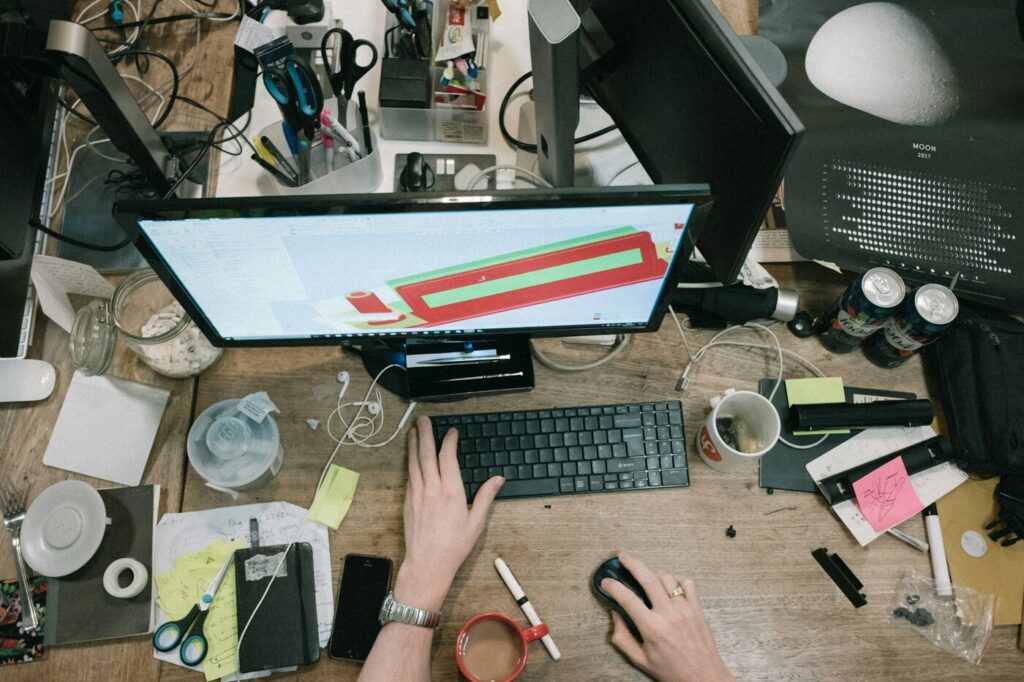
How much effort should you put into getting your home workspace ready for your digital grind?
Taking shortcuts in designing your home office may seem expedient, but in the long run, it’s a costly compromise.
Neglecting your home office setup isn’t just about losing productive hours; it’s about inviting discomfort into your daily routine, such as the following:
- Imagine dealing with back, neck, and wrist pain, all stemming from bad furniture choices like a subpar desk/chair combo and poorly positioned monitors.
- Distractions like noise or clutter can seriously hinder your ability to concentrate and meet deadlines.
- A cramped or chaotic space might further add to your stress levels.
Yet, some thoughtful planning can work wonders, whether you are dealing with limited space or aiming to supercharge your productivity. One-off changes can cause drastic improvements.
From quick makeshift adjustments to transformative alterations, we’ll explore how to create a home office that’s not only functional but incredibly productive.
Optimize Space: Figure Out Your Home Office Size
First, let’s figure out your home office size. While you may want to gloss over this detail, it can make or break your productivity.
When living in a small space, every square foot is valuable.
Knowing your home office’s spatial limits, you can effectively turn your space into a productivity powerhouse – even when dealing with a small space. You can make changes, such as the following:
- Add compact and multifunctional furniture and tools to your workspace
- Re-position furniture in a space-efficient way that maximizes functionality.
Further, knowing your home office limits help prevent the workspace from encroaching on other essential areas of your home.
At the very minimum, you should set aside at least 21 square feet for your home office. That is 55 inches by 55 inches (4.6 ft by 4.6 ft), providing enough room for a mid-sized desk (50″ W x 30″ D) with dual monitors. It also takes into account space behind your chair for getting in and out easily.
As long as you have approximately 21 sq ft available, you could make it work. Yet, unfortunately, this would likely disqualify certain nooks and corners of your apartment.
If you require more space (for desks, tools, or storage) or would like to make exact measurements, read this article:
Side note: Opting for a smaller home office encourages minimalism and forces you to focus on essential items. This approach is beneficial for those who value flexibility and want the ability to pack their office into a bag with minimal disruption. When constructing your home office, prioritize functionality over excess gadgets, and a small space can often suffice.
Decide Wisely Where to Set Up Your Office
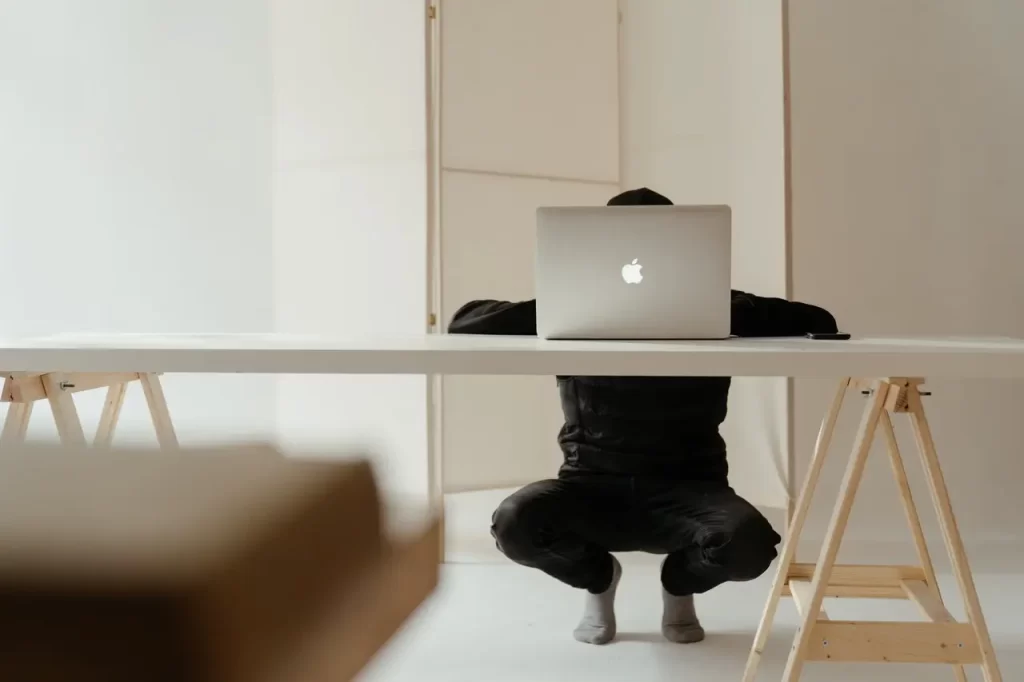
Beyond merely meeting the minimum size criteria for a home office, you have to decide where to set up your office.
Here are some most common constraints:
- Lack of a spare room: While having a spare room for your office is undoubtedly the ideal scenario, not everyone has this luxury.
- Inability to customize your home: Many people are unable to totally customize the design, layout, and furniture within your living space.
These constraints might apply to you – you might lack a spare room and the ability to make significant spatial changes. If you live in a small space, rent, or have a limited budget, you may need to be flexible and creative when selecting the perfect spot for your home office.
Before you fixate on any given area, be sure to carefully examine all the different areas of your home – consider your kitchen, bedroom, store room, family room, and other viable options you have.
Consider how you can maximize each potential area, weighing their pros and cons.
When choosing your space, here are some requirements to keep in mind.
Must-haves:
- A good desk and chair
- Proper lighting
- Effective temperature control
- Power outlets distraction-free environment
Good to-have items:
- A dedicated workspace separate from areas like your bed to maintain work-life boundaries
- Ample space for storage, movement, and minimizing clutter.
Living Room vs Bedroom vs Kitchen Workspaces
If you’re living alone, the living room may be the best option.
The living room, being the typically most spacious area in an apartment, provides ample room for setting up a desk and making personalized furniture adjustments. This room offers considerable flexibility, allowing you to make both minor and major changes without disrupting essential functions such as sleeping or dining, making it an ideal space for your home office setup.
Consider the bedroom as a second option, providing a private and convenient workspace.
Alternatively in the kitchen, consider utilizing a dining table, countertop, or shelves as viable alternatives for creating a functional work area.
Related: Living Room or Bedroom: Where to Locate Your Home Office
How to Transform Your Living Room: Makeover vs Integration
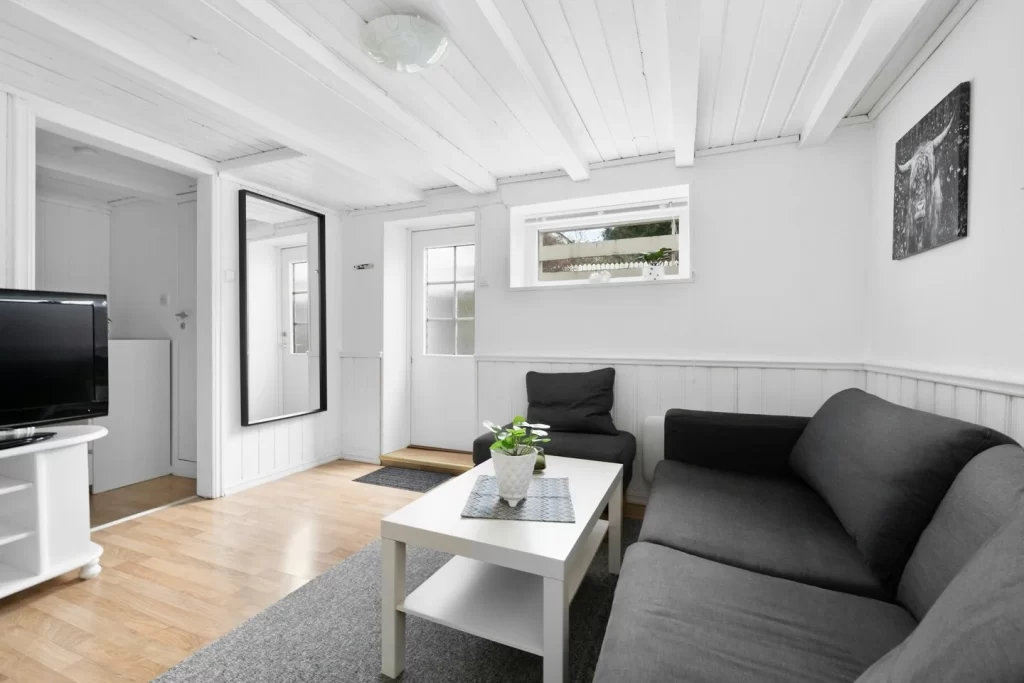
For ultimate productivity, the first option you have is a living room makeover.
Consider transforming your ENTIRE living room into an office space. It doesn’t mean you have to spend money or hire a professional. Instead, if you’re super serious about productivity, you can simply use your living room as just an office.
Here’s why you should strongly consider a makeover:
- Dedicated Workspace: By designating your living room as your office, you have a spacious and dedicated workspace.
- This can signal to yourself (and others) that when you are in this space, you are focused on work, reducing the likelihood of unnecessary interruptions.
- Establishing a Routine: When you consistently use the living room as your office during specific hours, it helps establish a routine.
- Removal of Visual Distractions: To enhance concentration, you can choose to arrange your workspace away from distracting elements like the television. This stands in contrast to other rooms, where you have less flexibility to remove/rearrange key furniture items like your bed or fridge.
The second option is to integrate productivity with the living area.
This is what most people would feel comfortable with. You retain essential living room elements, whilst making productivity possible.
Having an office integrated in your living room involves selecting the right corners and walls, re-organizing furniture, and decluttering. You might even want your workspace ‘hidden’ and tucked away when not in use.
Whether you make small or major adjustments, here are some recommended choices of furniture:
- Space-saving furniture: This is furniture that maximizes the available area while preventing clutter, such as corner desks.
- Multi-functional furniture: Each piece serves multiple purposes without sacrificing space, such as using your couch as your office chair – if it is up to standard.
- Such furniture suits integration of your office with living room.
- Ergonomic desk setup: Prioritizes comfort and prevention of health issues.
- Such furniture is more suited to permanent changes and a living room makeover, where couches are replaced with ergonomic chairs, and tools like a sit-stand desk or laptop stand are utilized.
- Alternative desks: Enables flexibility of switching work surfaces. Examples are a lap desk or ironing board.
- Optimal lighting: To create a well-lit environment for increased focus. Improvements should be made as cool-white lighting for productivity is not prevalent in homes.
Making a Bedroom Ultra Productive: A Multifunctional Space
Unlike your living room, you can’t completely transform a bedroom into your office. You must be strategic and protective of your restful space.
The most challenging aspect about setting up a bedroom office, besides size constraints, is to ensure that it’s distraction-free.
There are numerous distractions in a bedroom. Your bed is the largest distraction as it lures you into comfort and leisure, whilst your TV is the second worst item if you have one. Thus it can be incredibly hard to stay disciplined and productive. And a bad setup can also ruin your restfulness and sleep.
Hence, you need to ask yourself how you can create physical separation of work-rest areas, making your desk area as distraction-free as you possibly can.
- Set up your bedroom office: Unlike other areas of your home, a bedroom office setup must be very carefully planned. I went in depth into 10 bedroom office setup tips for maximal productivity without compromising rest.
- Invest in the right furniture and tools: In particular, you need to put in careful consideration of your bedroom desk setup, lighting, and furniture choices.
- Stay productive: Adopt various strategies to stay productive. Using your bedroom as an office requires a lot of discipline.
Making a Kitchen Office Work
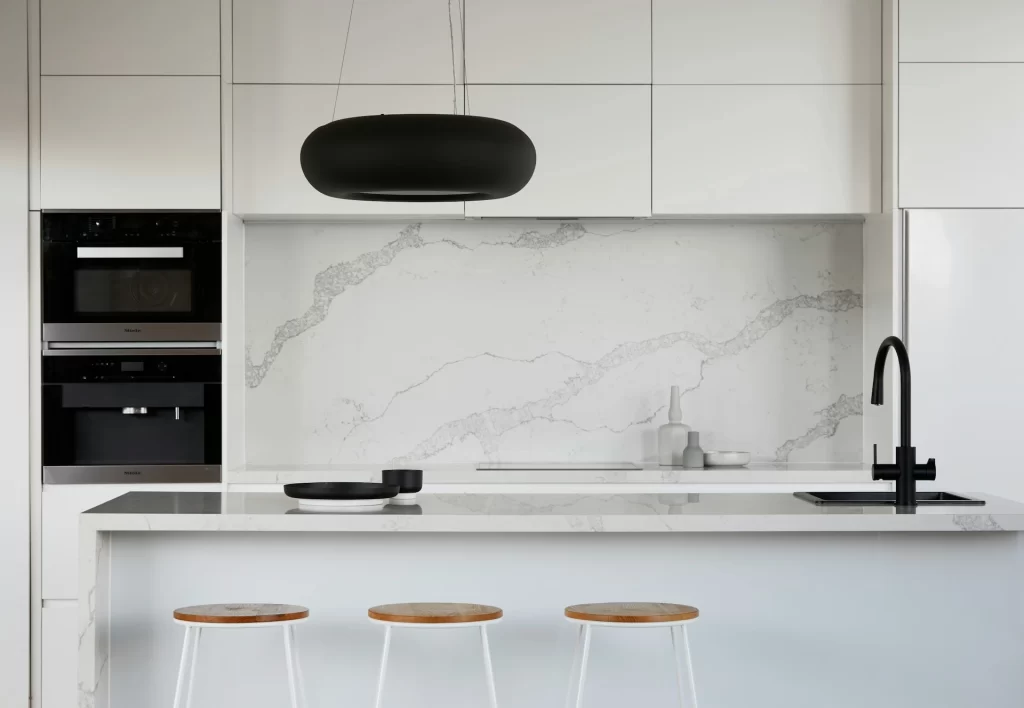
Another alternative is to utilize a kitchen as an office. There are simple, practical steps you can take to make a kitchen your office.
Like the bedroom, you can’t really do complete makeovers since you’ll need the kitchen for dining – even if you do not cook, you’ll still need the fridge and some cabinets to store food items. Yet compared to the bedroom, the kitchen gives you more furniture to work with.
You can utilize the kitchen as a makeshift office – where you make it work without making drastic changes. Perhaps you need to make some adjustments to your dining table to make it more ergonomic and comfortable.
If you like, consider longer-lasting changes, such as the following:
- Invest in furniture and lighting.
- Repurpose kitchen storage for office use.
- Adopt some space-saving furniture options (that may already exist):
- Work on your kitchen countertop with a laptop stand.
- Make use of wall-mounted shelving for your laptop or tools.
- Consider more serious measures for a healthier work environment:
- Eliminate junk food from your fridge.
- Stock up on healthy tea and beverages.
Like the bedroom, working in the kitchen can be very distracting but you can proactively make changes and manage this aspect.
Must-Have Items in a Home Office

Do follow this comprehensive checklist to ensure that you completely optimize your home office environment for a high-productivity lifestyle.
After selecting a room, it’s time to build your home office and fill up the space with essentials:
- Desk essentials include a good chair, an ergonomic desk setup, screens, cables, phone, and more.
- Environmental essentials include lighting, air conditioning, noise management tools, and so on.
When setting up a home office, it’s common for remote workers and self-employed professionals to focus on the more obvious essentials like a desk and computer, but overlook certain items that can significantly enhance productivity and comfort.
Don’t neglect tools for clutter management and distraction management. For instance, cable organizers can resolve the issue of untidy cables.
Optimization tools are also neglected. Such tools optimize unideal ‘default’ home setups.
While rooms in a home come with pre-existing lighting fixtures, a desk lamp with adjustable lighting can provide the appropriate amount of brightness and color temperature for focused digital work.
Further, many neglect a high-quality office chair.
One of the most common reasons is cost. High-quality ergonomic chairs can be expensive, and as a result, the tendency is to just make do with what’s available, even if it’s not ideal for long periods of sitting.
Worse, since humans have a remarkable ability to adapt to discomfort, you may become accustomed to the discomfort of your chair and learn to tolerate it over time – even if it negatively affects your health and productivity. Don’t do this.
This article was originally published on unboundist.com. If it is now published on any other site, it was done without permission from the copyright owner.
Items to Remove for Improved Productivity
What about items to eliminate? This is also something people do not think about.
Likely, there’ll be 2-3 items that you can further eliminate from your home office. Most people have too much ‘stuff’. Few individuals are optimized when it comes to a home office. There was a day when I went through the stuff I have in my home office, only to realize that the excess that I had.
Here’s a comprehensive list of 17 items that you can eliminate from your home office. They’re grouped under one of 3 categories: distractions, bad arrangements and setups, and the removal of items to enhance digital workspace efficiency.
Set Up a Productive Environment: Ergonomic Desk
Every ultra-productive home office environment involves a designated desk – an ergonomic one.
An ergonomic desk setup goes beyond sit-stand capabilities. It involves various components, including the chair, desk surface, legroom, screen height, keyboard, mouse, and lighting.
To what extent should you care about an ergonomic setup? Its importance is underscored by the fact that your home office serves as a daily workspace.
If you use a poorly designed workspace every day, it can contribute to cumulative stress on your body over time. Thus it’s essential to prioritize ergonomics for long-term health even if it’s ‘troublesome’.
In fact, the basics are not hard to figure out. Here’s how to set up your desk ergonomically, with key attributes clearly laid out:
- Desk attributes: Ensure you take care of your desk surface area, available leg room, and consider sit-stand capabilities
- Pair the right (ergonomic) office chair with your desk
- Ergonomic device placement: Use good screen positioning and keyboard and mouse placement
- Set up good lighting
A popular aspect of an ergonomic setup is the component of standing versus sitting. As digital workers, we sit for too long and it causes us health and productivity issues. Certainly, you can improve productivity with a sit-stand desk by changing your habits, by standing where you get tired from sitting, and working while you stand.
Set Up a Productive Environment: Lighting
It’s important to manipulate lighting to achieve optimal productivity and well-being. This goes back to optimizing your environment for a high-productivity lifestyle.
Frequently, we rely on the standard lighting in our homes for our home office without exploring alternative or optimized options. Yet, the default lighting in homes may not be built for prolonged cognitive tasks that demand concentration.
Settling for warm-white lighting (3000K and below), commonly found in homes and appearing yellowish, is suboptimal for a productive workspace, as it’s more conducive to creative and winding-down activities.
Instead, you should Ideally aim for at least 4000K blue-white lighting.
When designing your home workspace and its colors, recognize that different light colors in your home office induce distinct states of mind that you can intentionally construct.
If your home office lacks windows or natural light, consider enhancing its brightness by introducing additional light sources. You can achieve this with the following ideas:
- Adjusting the proximity of existing light sources
- Changing the types of bulbs and fixtures
- Modifying the colors and intensities of the lights.
There are numerous ways to effectively light an office, providing ample solutions even if you find yourself in a temporarily dark or cramped room.
By proactively changing and enhancing your lighting setup, you not only improve workspace brightness but also cultivate an environment that’s conducive to accomplishing your tasks and achieving your goals.
Alternative Desks
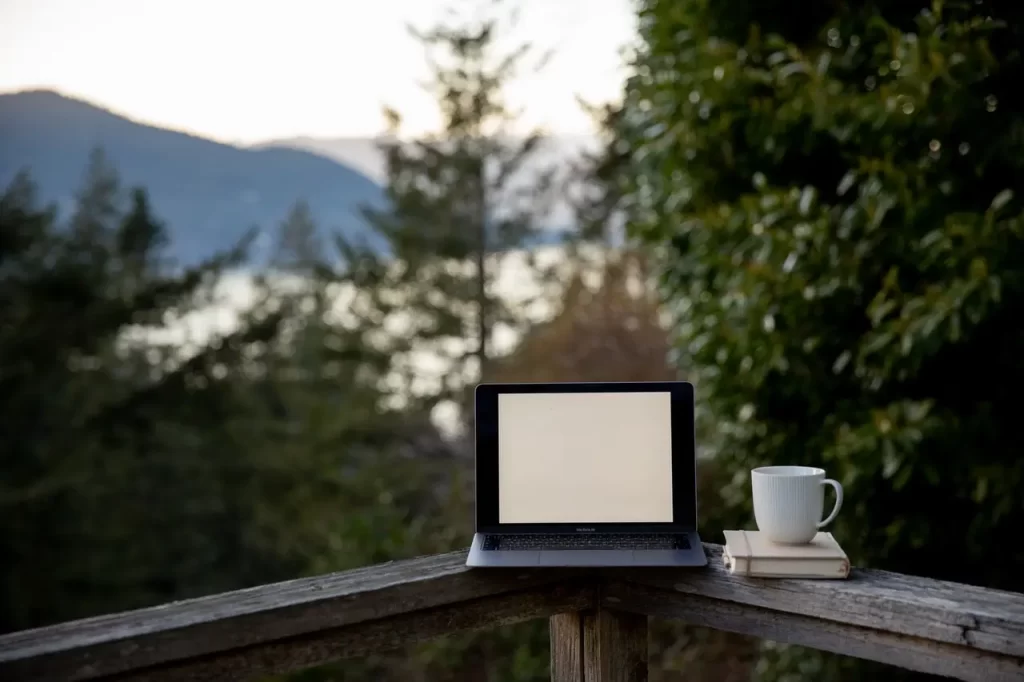
If you frequently seek a change of environment from your usual desk or find yourself without reliable access to one while traveling, here’s what you should do: Look into alternative desks.
Alternative desks are about functionality and flexibility. It’s all about staying productive even when you’re not utilizing a conventional desk. They can be a life-saver or time-saver wherever you go. Developing the ability to work comfortably in various settings is a valuable skill, especially for those aspiring to function as portable professionals.
There are several alternative ways to maintain productivity even without a conventional desk. While these options may not be ideal, they are workable on occasion. Consider the following examples:
- Laptop Stand: Convert an unused flat surface in your apartment, such as the top of a cabinet, a coffee table, or a kitchen countertop, into a functional workspace using a laptop stand.
- Lap Desk: Use a lap desk while sitting on a sofa, bed, or any other comfortable seating area. This versatile option allows you to change your working environment and posture to prevent fatigue.
- Ironing board: In a hotel or Airbnb, an ironing board can serve as a makeshift desk, offering a better or alternative solution to working on the floor or bed. Besides, everyone has an ironing board at home.
Some of these items let you set up alternative ‘offices’ each day.
Whether it’s a portable folding table, lap desk, or ironing board, you can easily adapt and work in a different room when needed – an extra 30 minutes of productivity when you’re tired can work wonders.
Some of these items may become part of your portable office toolkit, useful even during travel and business trips. A laptop stand is one valuable tool for mobile professionals.
Share a Home Office Space: Strategic Tips
Sharing a home office space can be a tricky issue that can potentially cause conflicts, stress, or feelings of intrusion.
Fret not – Having lived with family members and flatmates while working from home, I’ve had to calibrate my strategies, and found success.
I’ve delved into 11 practical tips on how to share space efficiently, including setting up multiple work zones, using designated shared offices, and establishing clear boundaries and schedules.
Some of these tips will resonate more with you than others – pick and choose a mix of them to apply in your personal living situation. Calibrate and iterate until you find a combination of strategies that work best for you.
Alternatives to a Home Office
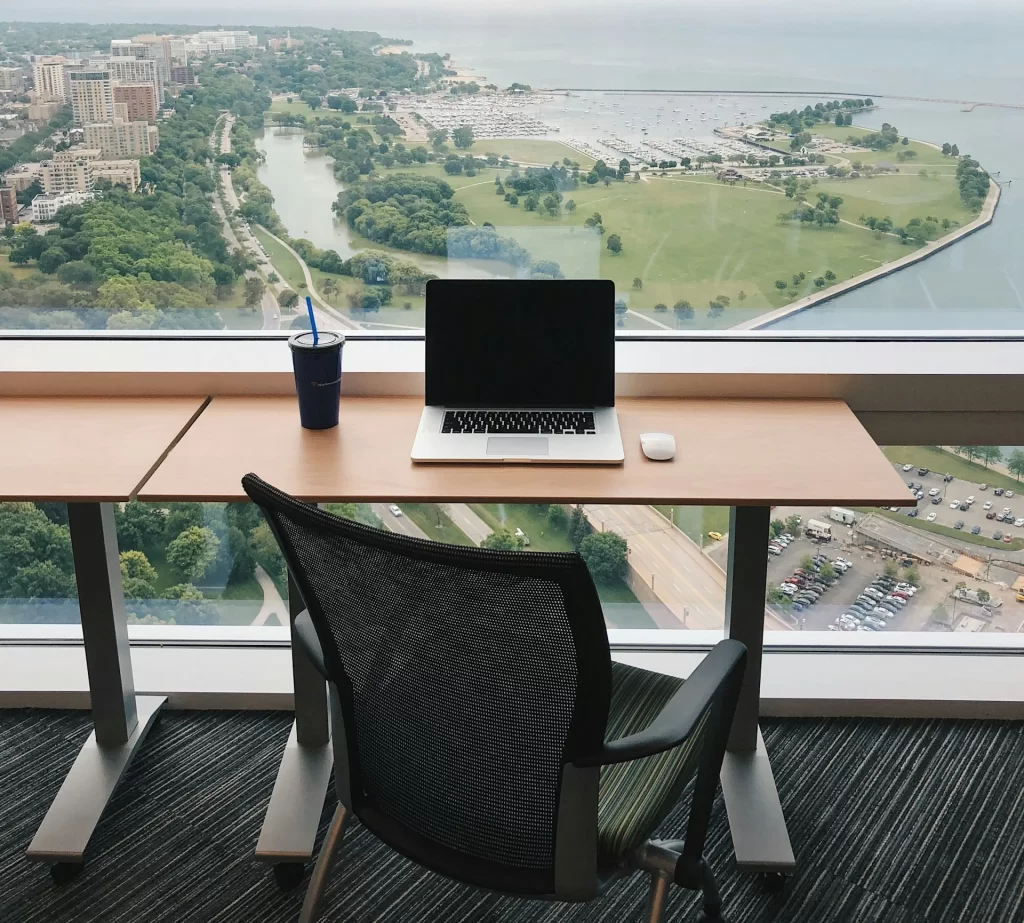
Finally, what if your home office proves to be inadequate or you simply yearn for a change of scenery?
Even if you’re capable of designing an efficient home office, it’s wise to come up with backup plans.
Mastering the art of maintaining work functionality as a remote worker or mobile professional is a crucial skill.
The broader the range of places you can be productive, the greater your work functionality, and thus you can maximize more time. This flexibility allows you to adapt to changing environments seamlessly, minimizing downtime and disruptions.
In a vibrant city, the opportunities to discover conducive workspaces are plentiful. With strategic planning, you can unlock a myriad of options for remote work.
As these locations affect your productivity, they must be somewhat affordable, yet reliable.
When scouting for alternative places for your digital endeavors, prioritize factors such as the following:
- Available seating
- Reasonable prices
- Limited distractions (including noise and crowds)
- Accessibility of charging points.
Here’s a guide to precisely identify what to look for in alternative workspaces beyond your home office, so you never run out of options.